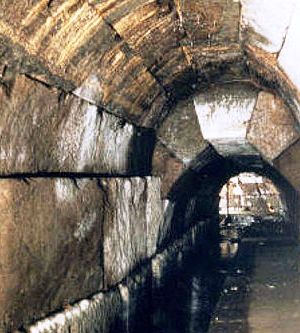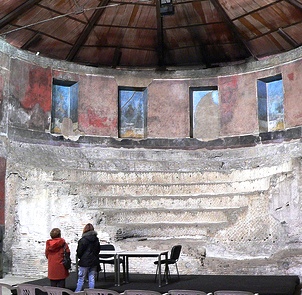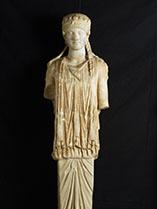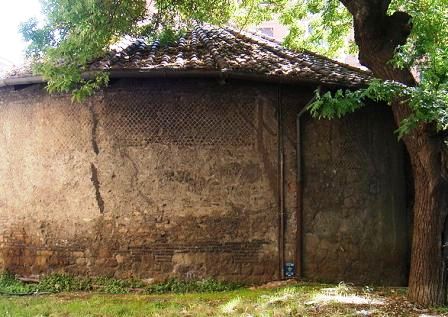|
|

Gaius Cilnius Maecenas
(70-8
BCE),confidant and political advisor to Augustus, the first
Roman Emperor.
Photo courtesy Cgheyne, Wikipedia. |
|
Etruscan Notable
People:
We know the names of some Etruscan generals.
We know the names of families who owned burial tombs.
We know the names of some political leaders.
Beyond names, we are clueless.
We can’t locate the burial place of even a single Etruscan King
or ruler.
Lucky for us, Rome
was a magnet for
the ambitious and welcoming of immigrants. Two notable
Etruscans benefitted: Tarquin I and Maecenas.
Both found fame and fortune in the Eternal City.
|
| |
|
|
| |
|
|
Tarquin
I, also known as Tarquin
Superbus
lived around 600 BCE. He was the fifth of
the seven "Kings of Rome."
He immigrated to Rome from the Etruscan city of
Tarquinia; evidently his hometown did not
welcome his Greek wife.
The Etruscans had mastered large drainage
problems, devising the cuniculus drainage system.
Tarquin I,
drawing upon this tradition, tackled the
bogs of Rome. His result was the Cloaca Maxima,
which drained the marshes of of the Roman Forum.
The
Cloaca Maxima also carried sewage; jettisoning it into the
Tiber
River, the CM produced a notably healthy and
clean-smelling city
(unless you lived close to the Tiber).
|
|

Cloaca Maxima,
(perhaps)
Rome, today.
Photographer unknown. |
| |
|
|
Tarquin I
started
the
largest monument of the Etruscan- Roman era. This was the
Temple
of Jupiter Optimus (Best
and Greatest.)
Placing the Temple
on top of the Capitoline Hill, an elevated sacred space, was
meant to produce awe and fear in the surrounding villages and
towns. The Temple,
larger by far than anything yet built,
could be seen for miles, standing out as the destination point
for those traveling to Rome.
Part of its shock came from the newness of its design: it
showcased Etruscan temple traditions. An Etruscan temple had
a high, square podium, widely spaced columns, a broad,
overhanging roof made of red clay tile, and elaborate decoration
and statuary made of terracotta. Buildings in the city of Rome
at the time were modest and wooden, with thatched roofs.
A statue of Jupiter, meant to link Tarquin the King to Jupiter
the God, reigned in the middle. Statues of the goddesses Juno and Minerva
flanked him.
Who paid for the monumental Temple? The unfortunate towns and cities conquered
by Tarquin I and his Roman army.
Today, only a few building blocks exist as part of the
Capitoline Museum in Rome. |
|

Temple of
Jupiter Optimus (Best
and Greatest)
Rome. The
temple no longer exists. Model at the Museum of Roman Civilization, EUR, Rome.
N
Photo courtesy of Vroma.
http://www.vroma.org/images/
mcmanus_images/capitoline_temple.jpg |
| |
|
|
| |
|
|
| |
|
|
About 500 years after Tarquin I, we have Maecenas, 70 BCE-
8 BCE (photo above).
His ancestors,
of whom he was proud,
came from the Etruscan city of Arezzo, Arezzo is about 50 miles from Florence.
Maecenas was a political advisor and confidant to
Emperor Augustus. He arranged
Augustus’ marriage to Scribonia. It appears Maecenas later fell out of the
Emperor's favor, some said because Augustus coveted Maecenas’
own wife, Terentia.
A poet himself, Maecenas
provided crucial
support to the Roman poets Virgil and Horace.
Maecenas has become a byword for
the altruistic, wealthy patron of the arts.
|
|

Maecenas' Gardens: The Banqueting Hall
("Auditorium").
1st
c AD. Rome. Photo courtesy T. Myrup.
In his banqueting hall poetry readings
were (perhaps) given, with listeners seated on the steps.
Frescoes of garden scenes were inside the niches to bring in the
outside gardens. There may even have been a waterfall inside the
hall. |
| |
|
|
Maecenas
used his very considerable wealth
to establish a luxury garden. The garden was located on the higher ground of the
Esquiline Hill. The Hill was across the old city walls and the burial pits of
the poor, which lay just outside the city walls.
Maecenas spent the last 15 years of his life in his garden
estate, patronizing the arts. |
|

Maecenas' Gardens: Greek
Woman Garden Statue.
Marble. 1st c AD. Capitoline
Museum, Rome. Photo courtesy IMSS. |
| |
|
|
The Imperial family inherited Maecenas' property after his
death, and loved his garden estate for generations.
Emperor Tiberius resided there, and Emperor Nero
is said to have watched the Great Fire of Rome of AD 64
from a tower in Maecenas’ Garden.
Today, the banqueting hall-auditorium remains standing and is open to
visitors.
|
|

Maecenas' Gardens: Banqueting
Hall ("Auditorium").
1st c AD. Rome.
Photo courtesy
Lalupa. |
|
|
|
|
|
You may contact me, Nancy Padgett, at
NJPadgett@gmail.com |
|
|
|
|